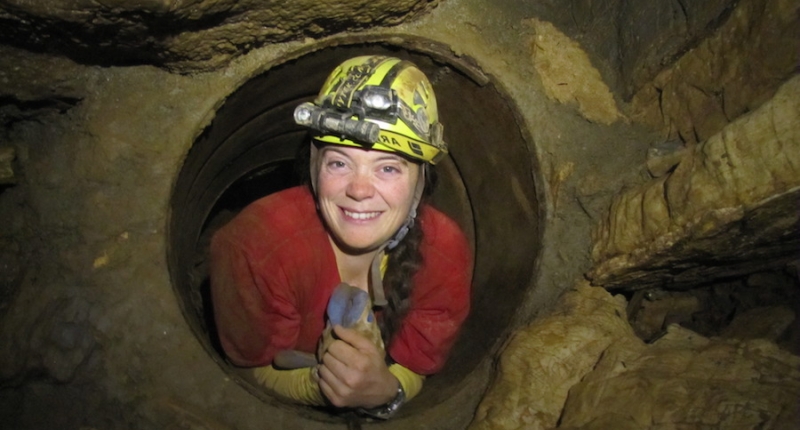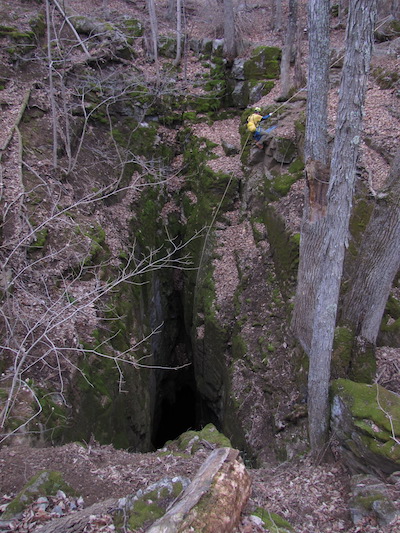NCEAS Portraits: Skylar Hopkins, Parasite Ecologist, Blogger and Caver

Like many early career scientists who come to NCEAS, Skylar Hopkins began her scientific journey as a “muddy boots ecologist.” Unlike many others, her initial career aspirations were not in science, but in history and elementary education.
A few twists and turns in college led her to ecology and, eventually, that of parasites. By graduate school she found herself also donning the hat of a statistician, after counting snails and their parasites for her dissertation research resulted in “the accidental creation of the most statistically complicated datasets known to mankind” (her words).
Her stats experiences and realization that mountains of unused data are lying in wait for someone to analyze them steered her to the world of synthesis science at NCEAS, where she is now a postdoctoral researcher with the Ecological Levers for Health working group under the Science for Nature and People Partnership.
An avid caver, an experience she likens to being an astronaut, and blogger about parasites, Hopkins is one of the newer faces at NCEAS who brings a perspective that surely adds to the diversity of people who make up our community. We got to know a little more about Hopkins in this month’s Portrait.
What questions are you most interested in solving?
Hopkins: I have many interests, but all of my favorite research questions involve the transmission of infectious diseases. Right now, our SNAPP project is holding much of my scientific attention. Our working group is exploring the intersection of biodiversity/ecosystem conservation and human infectious diseases to understand when and how we can find win-win solutions that advance conservation goals and reduce disease.
Why did you get into your line of work?
Hopkins: It’s still shocking to me that I turned into a quantitative ecologist. I entered the University of Maine at Farmington as an elementary education major, with a general plan to specialize in history and avoid math and biology at all costs. To avoid taking a non-majors biology course in my first semester, I enrolled in environmental geoscience. I’m not sure whether I loved the professor or the field trips more, but I quickly decided to become a scientist. I actually thought I was going to become a paleontologist, but then another favorite professor set me loose on western Maine with a butterfly net and a backpack full of glassine envelopes, and my interests shifted to studying and conserving living animals.
At first, I decided I was going to be a marine conservation ecologist, and I applied for something like 40 summer internships. I was rejected by almost all of them! But at the eleventh hour, right before I took up a rotten fast food job, I was offered an internship studying freshwater snail parasites in Virginia. It sounded like a bunch of boring microscope work (sorry, I was young and naive), but I was desperate and accepted anyway. I ended up loving the research so much that I returned to Virginia for a second internship the next summer and for graduate school the year after. Since then, studying infectious diseases has provided me with seemingly endless opportunities to explore important basic and applied research questions.
What do you value most about your experience working with SNAPP?
Hopkins: The human dimensions aspect of our project has been really exciting for me. I spent the past few years working on basic ecological research questions, and I was eager to move into a more applied, conservation-oriented direction. I can’t imagine a better way to do that than by getting involved in a project that focuses on humans as part of natural systems, as SNAPP projects do. It’s amazing how much I’ve learned in a few months of collaborating with top scientists. The NCEAS model of working groups and synthesis science really does accelerate scientific progress!
What makes you so interested in parasites?
Hopkins: It’s easy to be interested in parasites – they’re awesome! For full details regarding their awesomeness, you’ll need to check out my blog, but I’ll give you two reasons here: parasites are ubiquitous and diverse. There are estimates that at least 40% of all animal species are parasites. We’ve found parasite species on or in every host species that we’ve examined – there are even (hyper)parasites living on parasites! That’s an incredible diversity of morphology and life history.
 What benefits have you found in blogging?
What benefits have you found in blogging?
Hopkins: I blog as a form of outreach. So my primary goal isn’t to personally benefit from blogging. In fact, until a few months ago, only a few people knew that Parasite Ecology was my creation, because I blog under a pseudonym.
That being said, I could write a whole post (or two!) about the unexpected benefits of academic blogging. For instance, blogging inadvertently gave me my thesis. I ended up turning my intended first chapters into side projects after I wrote a blog post about density versus frequency dependent transmission functions and subsequently switched my dissertation focus to new questions regarding transmission functions.
Blogging also helps me keep up with the literature, connect with people within and outside of my field, and slowly, maybe, possibly improve my cartooning skills.
What keeps you inspired outside of work?
Hopkins: I’m a strong believer in work-life balance in academia: work hard, play hard, sleep hard, and eat burritos. I usually budget ample time each week to go caving – which is like spelunking, but better. Unfortunately, Santa Barbara is a cave desert, so I’ve recently been forced to exist primarily aboveground. But it’s been fun to spend time hiking with my dog, climbing boulders and crags in the mountains, and devouring books.
What excites you about caving?
Hopkins: Caving is as close as most of us will ever get to visiting a beautiful alien landscape. Astronauts even train for their space adventures in caves! There’s something indescribably special about hiking up to a giant hole in the Earth, rigging a rope onto a nearby tree, and rappelling 160 feet down a black pit filled with glowworms. I also enjoy physically and mentally pushing my limits by visiting these extreme environments. You grow as a person when you’re forced to rely entirely on yourself and your close friends to safely complete challenges that you wouldn’t have dreamed of tackling days before.
###
NCEAS Portraits feature the people behind our work and impact.
